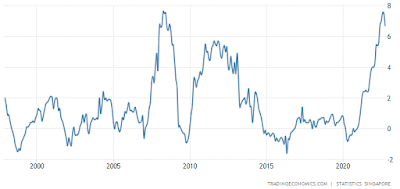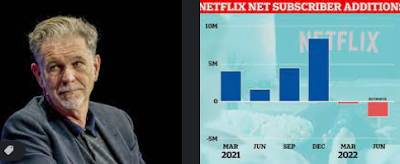Time files. We are coming to the end of 2022 and it is always good to take stock at such timing. How was the year? Did we have anything to celebrate? What are the lessons learnt? As of this writing, there is nothing much to celebrate. We are still not out of the COVID-19 pandemic. We have a war in Ukraine and the global stock market has corrected on average 17% since the start of the year. Nasdaq is down almost 30%.
NASDAQ -28%
HKSE -25%
DAX -21%
SPX -17%
Nikkei -10%
STI -1%
Surprisingly, STI is flat while most markets are down double digits.
Valuations remain high despite interest rates going up. More importantly – the risk-free rates are going up! As you may recall from those textbook studying days, risk free rate forms the basis of all valuation. If I can earn 4% risk free, which is what the
Singapore government Treasury bills give today, very broadly speaking, there is no reason to buy any stock with PER > 25x i.e. earnings yield < 4%. Why should I take risk to earn 4% or less when I can buy T-bills which are risk free and giving me 4%?
But global stock markets have not caught up with this logic. The following are the PER and EV/EBITDA ratios for the same markets:
NASDAQ PE 26x EV 15x (vs low at PE 21 EV 10x in 2012)
SPX PE 18x EV 12x (vs low at PE 13x EV 8x in 2011)
Nikkei PE 15x EV 9x (vs low at PE 14x in 2018 and EV 7x in 2011)
HKSE PE 11x EV 9x (vs low at PE 9x EV 7x in 2011)
DAX PE 11x EV 7x (vs low at PE 11x EV 5x in 2011) -> DAX looks cheap!
STI PE 11x EV 12x (vs low at PE 9x and EV 10x in 2011)
Source: Bloomberg
Long term investors who had looked at a few cycles may recall that T-bills was not 4% when these valuations hit their lows in 2011-12. Japan has a different story back then and today and at PER 15x, it is not screamingly cheap, even though the yen is and everyone and his dog is in Tokyo buying luxury products. Germany, Hong Kong and Singapore look like of cheap, but clearly the US markets look expensive when compared against the current interest rate environment and with other markets. It is also expensive when compared against its own history. The SPX needs to be closer to Mar 2020 bottom of 2500 for valuation to make sense, assuming earnings hold up.
The old story goes as such, if US is not cheap and US falls, then the other markets will not be spared. Remember the old adage - when US market sneezes, the world catches a cold. Hence a lot of investors are bearish. Some are saying there will be a big, big crash e.g. GMO.
According to GMO, the markets should have collapsed pre-pandemic. We glimpsed that in Mar 2020 but then the huge rescue package from the various governments drove markets to new highs! At the end of 2021, the S&P hit its all-time high at c.4800 (see chart below).
This marked the backdrop of this crazy year. Since then, we had a war, inflation going through the roof, the shortest tenure UK prime minister and the meltdown of the GBP, the UK bond and stock markets, the assassination of a former Japanese prime minister and Donald Trump having a second go to be the world’s most powerful man after he messed it up big time last time!
Just when we think the world cannot be crazier, Koreans squeezed into a small alley to watch K-pop stars and got stuck, resulting in a stampede that killed more than 100 girls, an unthinkable accident in a developed country (my heart goes out to the families, pls pray for them). At the same time, we also realized China has become a prison and is forcing their rich and powerful (with the ways and means) to flee the country, pushing up home prices and rentals in Singapore!
So, how do you feel about 2023?
I would say this. We are not at the bottom. The war in Ukraine is escalating and inflation is here to stay. This means that global interest rates will stay high and the stock markets need to correct to lower valuations before we can say we are near the bottom.
Inflation will be a big topic in 2023. The following chart shows Singapore’s inflation for the past 25 years and we are at historical high. While the chart may seem to have peak out, anecdotal evidence tells us this is not the case. Rental cost in Singapore continues to rise, we are still seeing restaurant raising prices and importantly, as long as global issues causing inflation are not tamed, we will continue to import it due to the nature of our open economy.
Source: tradingeconomics.com
This brings us back to the STI. Recall that it corrected 1% while the rest of world has corrected double digits. Yes, we trade at lower PER (11x) but that is because of the constituents are mostly in the financial sectors which command lower multiples. Moreover, against our own history, we are not super cheap.
The only cheap market seems to be the DAX, but with the Russia-Ukraine war still looming large and the energy crisis unfolding, it is hard to bet on Europe. There might be individual stocks that might be interesting. Screening tools could come in handy. For the courageous, there is the option to buy some short ETFs but we need to be careful about the decay which can be 6-10% per year. Caveat: this is definitely not value investing and only seasoned investors should try this!
In conclusion, 2023 might be the year to just hold on tight. We shall wait for interesting names getting to interesting valuations as alluded in our first ever
real investment idea on
8percentpa.substack.com. But mostly, stay vigilant and stay liquid.
Huat ah!





